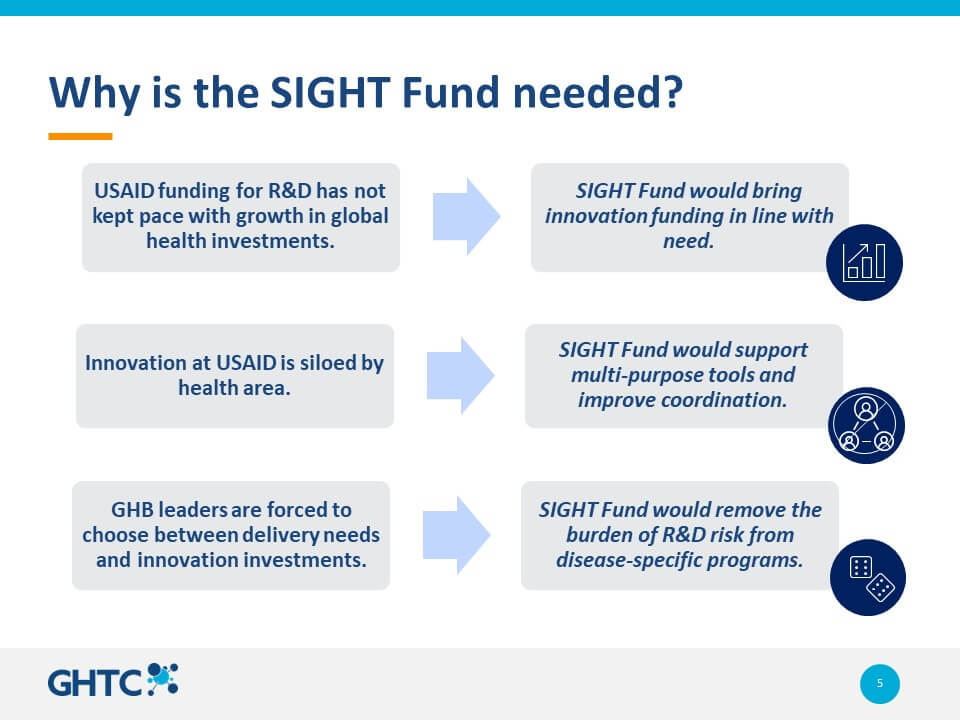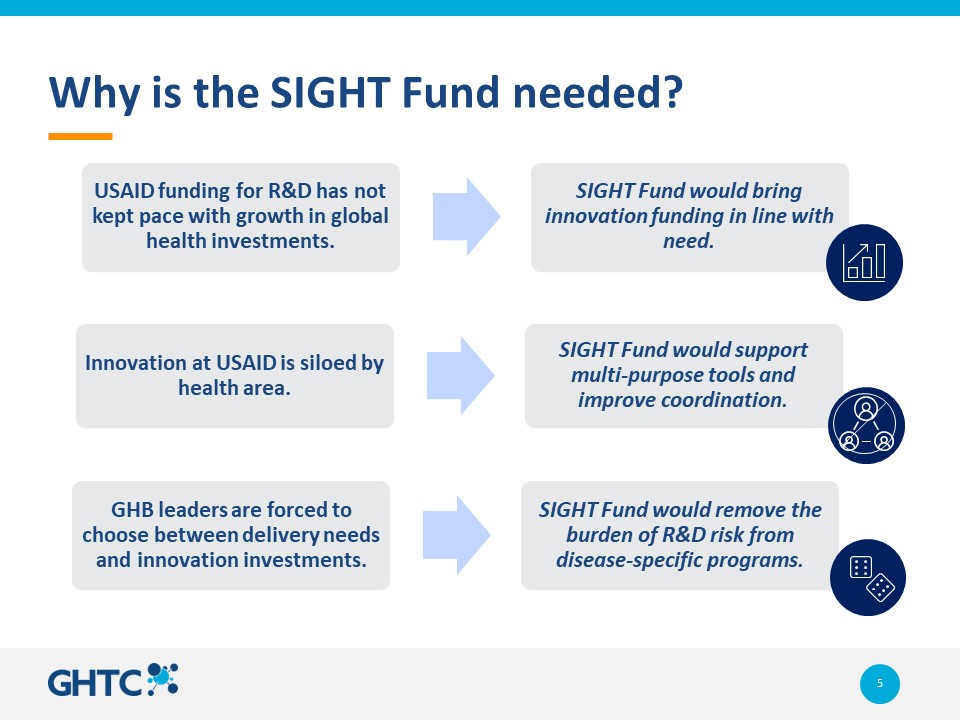Emily ConronGHTC
Emily is a senior US policy and advocacy officer with GHTC managing congressional outreach, policy development, and legislative analysis to support the US advocacy work of the coalition.
On May 16, with negotiations over fiscal year 2023 (FY23) appropriations underway on Capitol Hill, the Global Health Technologies Coalition (GHTC) hosted congressional staff and coalition members for a virtual briefing on the Supporting Innovative Global Health Technologies (SIGHT) Fund—a proposal for a new $250 million appropriations line in the FY23 State, Foreign Operations, and Related Programs bill dedicated to global health research and development (R&D) at the US Agency for International Development (USAID).
 Emily Conron, senior US policy and advocacy officer for GHTC, kicked things off with a presentation on the basics of the SIGHT Fund and the challenges it is designed to solve. She noted how 15 years ago, USAID spent about 8 percent of its global health funding on innovation, but that while USAID’s global health budget has doubled in that time, spending on innovation has not kept pace, dropping to less than 5 percent as a share of global health investment.
Emily Conron, senior US policy and advocacy officer for GHTC, kicked things off with a presentation on the basics of the SIGHT Fund and the challenges it is designed to solve. She noted how 15 years ago, USAID spent about 8 percent of its global health funding on innovation, but that while USAID’s global health budget has doubled in that time, spending on innovation has not kept pace, dropping to less than 5 percent as a share of global health investment.
She also emphasized that the pace of global health progress in the future will depend on the reversal of these investment trends today, with more resources urgently needed for R&D: “Today's global health tools like antiretrovirals for HIV/AIDS, oral rehydration therapy to save lives from diarrheal diseases, vaccines that have dramatically reduced child mortality globally—these tools are the product of robust R&D investments begun decades ago….We need to invest proactively today to ensure continued progress in global health in the years to come, and establishing the SIGHT Fund with an initial investment of $250 million dollars—which I should note is a level of investment representing less than 3 percent of all current US spending on global health—could really catalyze the development of tools that accelerate progress against emerging and enduring global health challenges. This would save US taxpayer dollars, maximize the impact of our programs, and ultimately improve and save lives around the world.”
Rachel Cohen, regional executive director of the Drugs for Neglected Diseases initiative (DNDi), North America, followed with the perspective of a leading global health product development partnership on why the SIGHT Fund could be transformative for global health innovation. She described previous R&D partnerships DNDi has had with USAID, but how budget limitations cut this promising work short—work that a new source of dedicated innovation funding could be tapped to continue. USAID’s disease-focused programs, with their limited funding, “shouldn't have to make these kinds of trade-offs—between critical funding for service delivery and funding for the next generation of lifesaving tools,” Rachel noted. “That's why DNDi is supporting the SIGHT Fund and why we need a mechanism that perhaps could be more crosscutting and catalytic.”
She noted how the fund could complement work advanced by other US agencies, ensuring that promising innovations do not languish in the dreaded R&D “valley of death” when early-stage R&D funding often drops off: “One important example of this would be, for example, to take some of the funding that NIH, the National Institute of Allergy and Infectious Diseases, is funding for broad-spectrum antiviral drug discovery,” she shared. “Once those tools are perhaps ready for clinical trials, USAID could fund the development of broad-spectrum and spectrum antivirals for a range of viral pathogens of pandemic potential.” She also noted new R&D areas the fund could support, such as funding “in a more transformative way the R&D needs of infants and young children, ensuring gender-responsive R&D, or addressing the health consequences of the climate crisis.”
Another innovator perspective was shared by Dr. Anand Anandkumar, co-founder and chief executive officer of Bugworks Research Inc. Anand shared background on the growing crisis of antimicrobial resistance (AMR), a global threat Bugworks is combatting through the development of novel broad-spectrum antibiotics designed to be affordable and accessible globally. “We all know from the experience of COVID that none of us is safe until everyone is safe—these are global problems requiring global solutions,” he reflected. “This [SIGHT Fund] could actually fill in a lot of key global gaps and make the United States a leader in connecting and finding solutions that are important globally.”
He shared a helpful image of a triangle to describe three interconnected gaps in the current global innovation ecosystem he believes the SIGHT Fund could help address. “One axis of the triangle is support funding of clinical development for phase 2 and 3 with an eye on LMICs [low- and middle-income countries],” he said. “There are already fascinating programs like CARB-X that have created a good pipeline to phase 1, fascinating programs like GARDP out of DNDi that are trying to support phase 2 and phase 3, and AMR Action Fund, that are trying to support phase 2 and phase 3—but that valley is a complex valley. It needs more support.”
“Number two, USAID, through the SIGHT Fund, can build clinical trial capacities on the ground in LMICs,” he noted. “You have patient population that have multidrug resistance, a very rich patient population—that’s the right place to do clinical trials, to find out how your drugs are going to work on the worst, difficult patients, but they [LMICs] don’t have capacities.”
“And third and last point: a fund like SIGHT could actually bring regulators together, take lessons from COVID, and accelerate these highly needed treatments for unmet population,” he concluded. “So one vertex of the triangle is supporting clinical development to plug the phase 2, phase 3 gap, one vertex is creating clinical trial capacities where it matters the most in LMICs, and the third is regulatory harmonization.”
The final intervention was made by Dave Milestone, former acting director of the USAID Center for Innovation and Impact, who shared what he experienced leading innovation activities during his tenure at USAID and why that has made him a supporter of the SIGHT Fund proposal today. “We know that there's a need for innovation,” Dave shared. “We're slowing our progress toward the achievement of our health SDGs [Sustainable Development Goals]. If we just go with sort of the status quo today, even if we deploy all the existing solutions that we have, there's a number of studies that say that we would still fall short. We need innovation. We need new local solutions. We need new partners, and we need to start with local problem solvers to make sure that we're identifying those right problems and then engaging the global R&D community to address those needs.”
Dave described several successful innovation partnerships from his time at USAID, including Grand Challenges, which crowded in new thinkers and problem solvers to address leading challenges such maternal and child health, Ebola, and Zika. But he noted that many of these partnerships, while very successful, were short term and ad hoc. “USAID funding for R&D and innovation isn't institutionalized. It's not consistent. It's not long term,” he emphasized. “We should think about a more strategic, holistic approach,” which he noted includes, but is not limited to, the level of funding: “It's also about crowding in the right skill sets and mindsets to how we work with innovation…bringing in the sort of people who understand the practice of innovation, who have portfolio management expertise. These are new skill sets and mindsets that should come with the [establishment of the] SIGHT Fund at USAID.” He concluded with a strong call to action: “If our goal is to end the need for foreign aid, then we need to do this. The status quo isn't cutting it, and we need to be prepared to solve tomorrow's problems with tomorrow's solutions—and the SIGHT Fund is an important step in that right direction.”
Jamie Bay Nishi, executive director of GHTC, finished the event by leading a question and answer session with the speakers, in which they emphasized the far-reaching impact that $250 million in new annual funding could have, how the fund could improve USAID’s responsiveness during health emergencies like COVID-19, and how it could advance not only discrete global health innovations, but also innovate the practice of R&D, strengthening the capacity of global partners to lead this work.
On this last topic, Rachel offered an inspiring closing point: “If COVID has taught us nothing, it's that …this whole concept that ‘trickle-down innovation’ is going to work—I think we have all been disavowed of that myth. By that, I mean [the belief that] all the innovation happening in high-income countries…[will, with enough good will] eventually make their way to low- and middle-income countries.” She emphasized that “the model of the future needs to be—especially for diseases that are highly prevalent in low- and middle-income countries—driven by the incredible innovation capacity that exists in those countries. But that cannot happen if all the money is flowing only to organizations and academic institutions that are based in high-income countries. We just have to break that cycle…[and] make sure that the experts, the scientists, the clinicians, and the policymakers from low- and middle-income countries are helping to set the priorities, to make the decisions, to allocate the resources, and ultimately to drive the innovation agenda of the future.”
You can watch the recording of the full session below, and learn more about the SIGHT Fund here.
